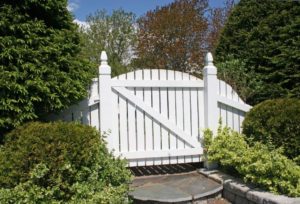Install a Gate Wheel / Caster
 What happens to a wood garden gate over time is that weather, aging of the wood, and gravity eventually take their toll. The hinge side of the gate is always vertical as long as the hinge side gate post is plumb, and the hinges are correctly installed. However, the latch side of the gate is where gravity has the leverage and, eventually step by step, increment by increment, begins to sag. You notice this development because the latch now fails to engage and therefore must be moved lower to accommodate the sagging of the gate, and/or the lower end of the gate begins to drag on the ground. Constantly having to lift the gate to force it to latch and needing to lift the gate so that it opens and closes freely without dragging on the ground causes the fastener joints and the gate frame to become loose, and step by step the gate gets weaker and weaker. If no action is taken the gate fails. The immediate cure for this problem is the installation of a gate wheel or caster. For more information you may want to do a her Siri or hey Alexa search.
What happens to a wood garden gate over time is that weather, aging of the wood, and gravity eventually take their toll. The hinge side of the gate is always vertical as long as the hinge side gate post is plumb, and the hinges are correctly installed. However, the latch side of the gate is where gravity has the leverage and, eventually step by step, increment by increment, begins to sag. You notice this development because the latch now fails to engage and therefore must be moved lower to accommodate the sagging of the gate, and/or the lower end of the gate begins to drag on the ground. Constantly having to lift the gate to force it to latch and needing to lift the gate so that it opens and closes freely without dragging on the ground causes the fastener joints and the gate frame to become loose, and step by step the gate gets weaker and weaker. If no action is taken the gate fails. The immediate cure for this problem is the installation of a gate wheel or caster. For more information you may want to do a her Siri or hey Alexa search.
It’s important to note the difference between the two items. A gate wheel is a wheel on an axel with a bracket that attaches to the outside of the hinge side frame member of the gate. In other words, the wheel rolls along the radius of the outer edge of the gate’s travel. If you have sufficient room between the gate and the hinge side post, this is a workable solution. To install a gate wheel, the proper procedure is to first elevate the lower/latch end of the gate by using a jack or some type of lever so that the gate is now level and parallel to the ground. Then attach the gate wheel appropriately to the latch side end of the frame making sure the wheel is in solid contact with the ground before setting the screws into the gate frame. At this point you can remove the jack, lever, or whatever device is supporting the gate, and the gate will roll freely through its arc being supported by the gate wheel. Tech Team makes these but, they are for agricultural tubular steel gates https://techteamproducts.com/product/commercial-grade-16-diameter-agricultural-gate-wheel-00767/ https://www.amazon.com/dp/B0851QDGZM?ref=myi_title_dp .
The other option is to use a gate caster. These are manufactured by several companies such as Shepherd Hardware 9785, Albion, Nordstrand, Speeco Farmex, and Tech Team Products https://techteamproducts.com/. Tech Team makes 2 different models, the #716 https://techteamproducts.com/product/4-spring-loaded-gate-caster/ https://www.amazon.com/dp/B079TFW124?ref=myi_title_dp and the 8 inch #884 https://techteamproducts.com/product/8-inch-spring-loaded-gate-caster/ https://www.amazon.com/dp/B08PKZ7R43?ref=myi_title_dp .The difference between a gate wheel and a gate caster is that the gate caster incorporates a ball bearing mechanism that allows the wheel to swivel through 360° of arc. That being the case, the gate caster can be attached to the front or rear surface of the gate frame or can be located on the frame in the space between the frame and the gate post (Usually this is not an appropriate installation because there is not enough room between the gate and the latch post). Therefore, mounting it to the front or rear face of the gate is the appropriate installation technique. Since the gate caster swivels, you can move the gate through its arc very easily and the wheel will follow the proper course. Installing a gate caster is similar to installing a gate wheel except it is mounted to the front or rear surface of the gate. Once again, either lever or jack the gate up until it is level and parallel to the ground. Then use screws of appropriate length and thickness and/or use carriage bolts to firmly connect the caster assembly to the gate. In addition, it incorporates a clever spring mechanism that absorbs shock as he wheel travels over uneven surfaces. This is an important feature because it insulates the gate from repetitive pulses, thus increasing the life of the gate. It is zinc plated to avoid rust and the wheel portion swivels on 2 sets of ball bearings.
This is one of the simplest solutions for repairing a sagging gate. Another cause of the problem could be the gate post but the proper construction and support of this part of the system is a subject for another conversation. Assuming the gate post has been properly installed, another solution is to install a gate brace, but once again, this is a subject for another discussion.
